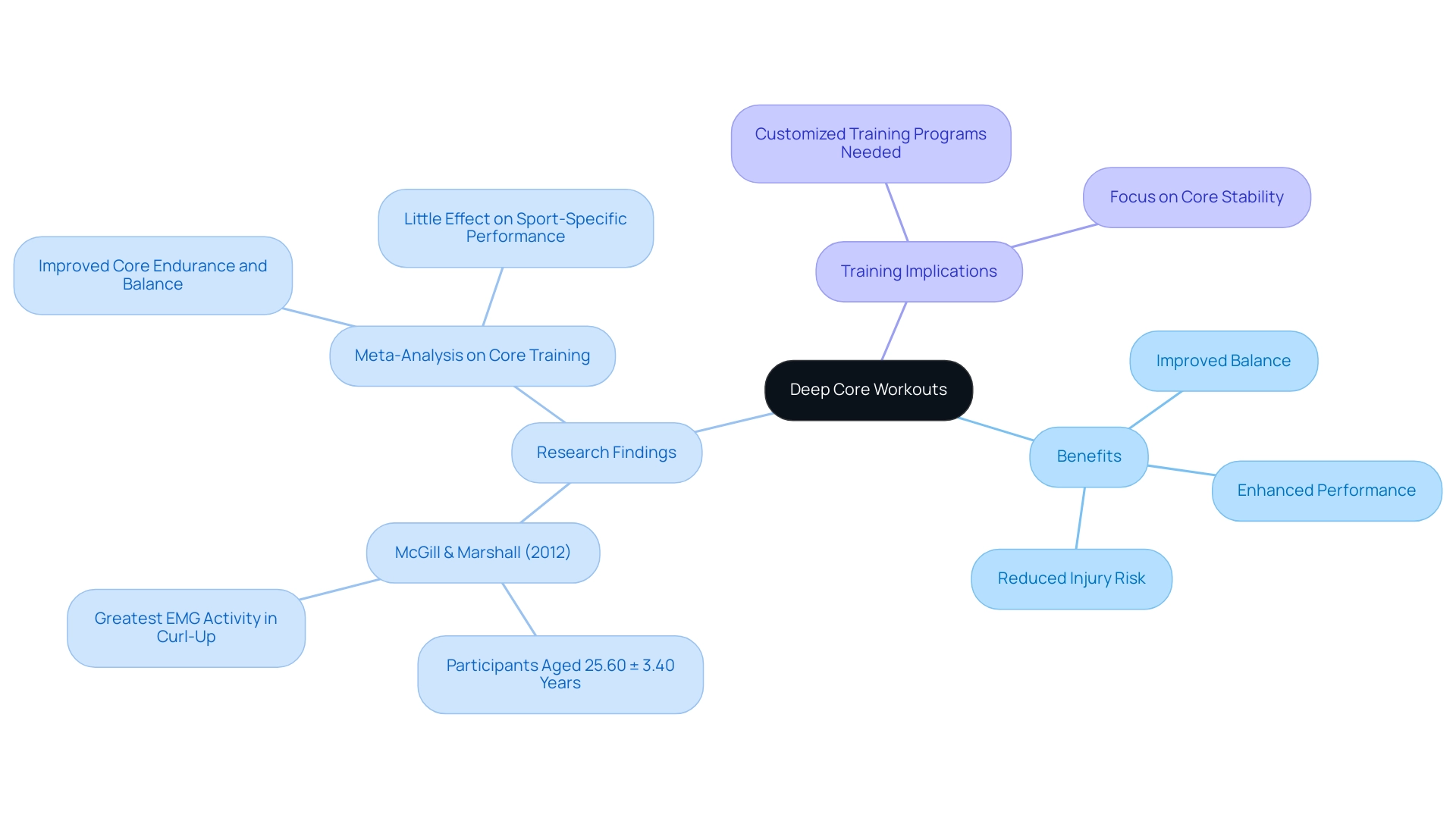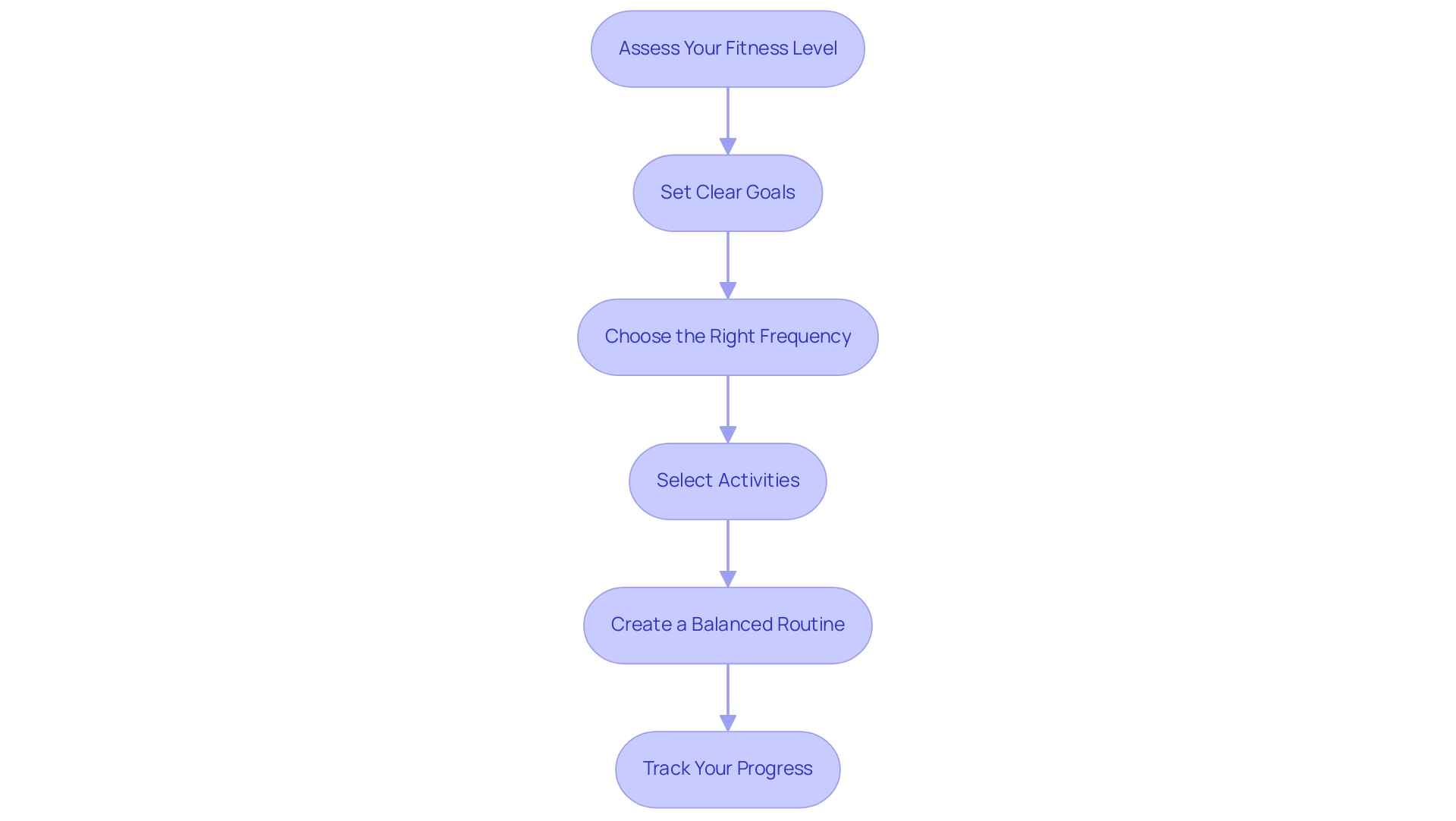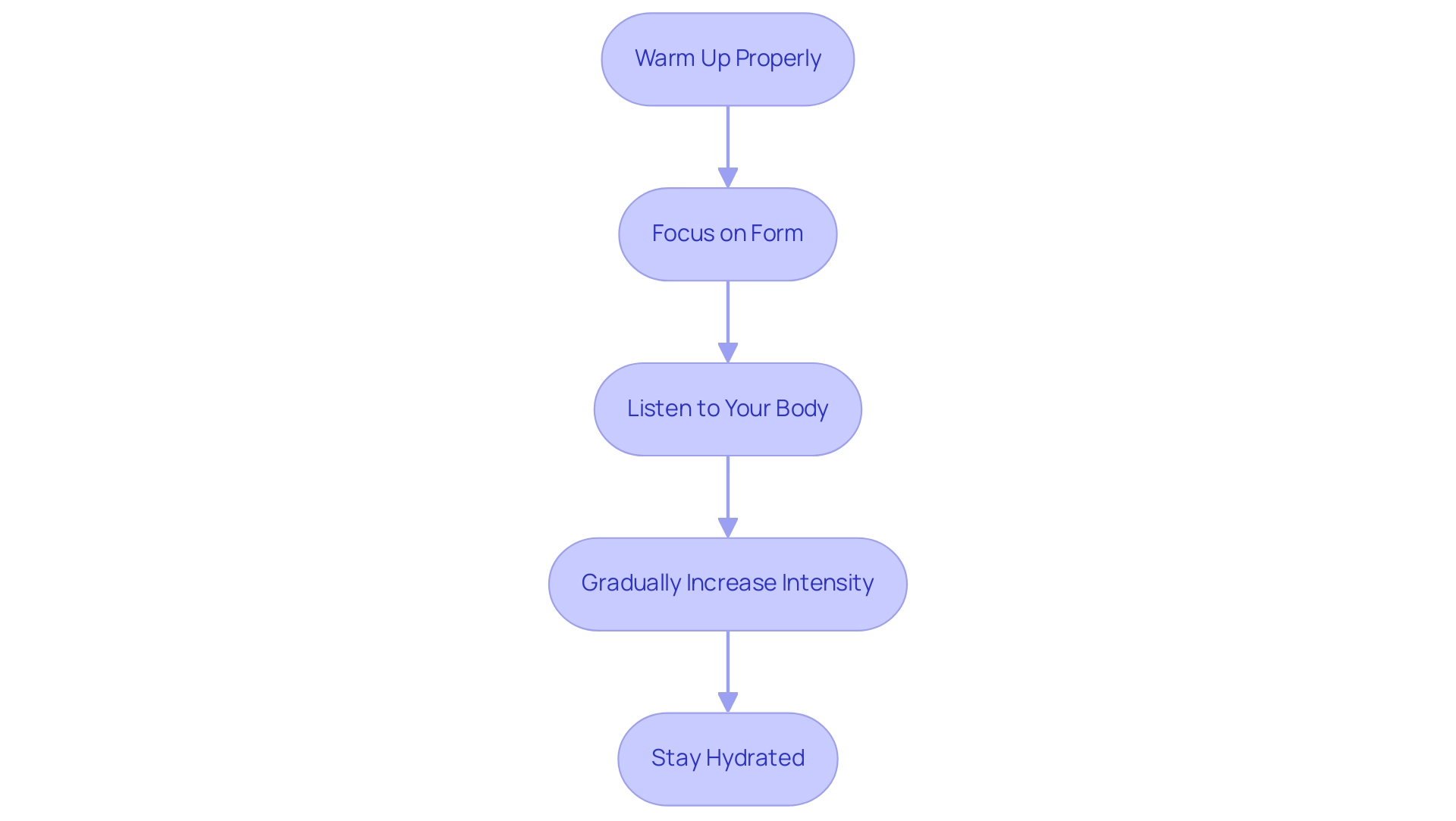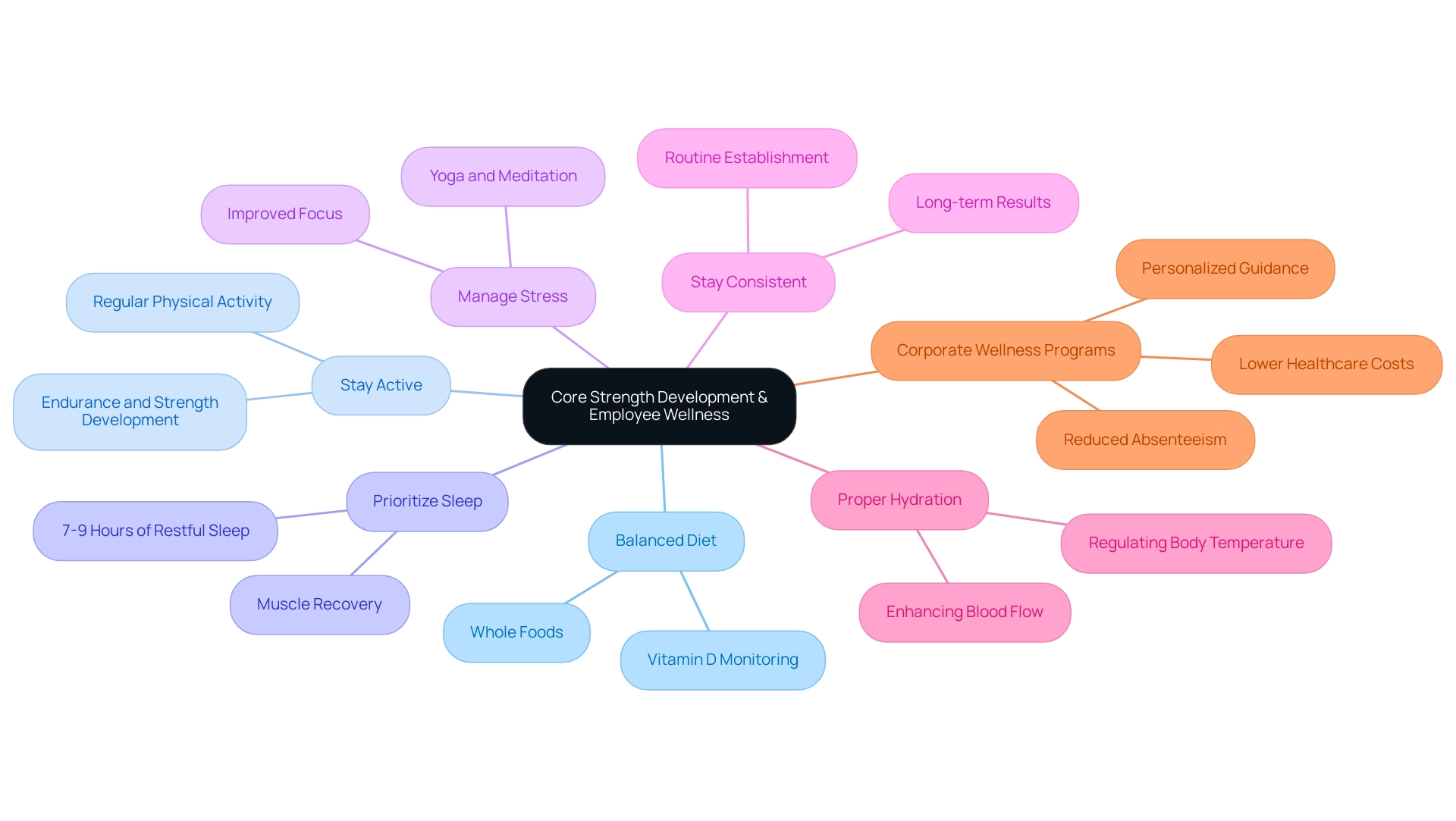Overview
To create a deep core workout plan, one should assess their fitness level, set clear goals, choose appropriate exercises, and ensure a balanced routine that includes warm-ups and cool-downs. The article emphasizes that a well-structured plan not only enhances physical abilities and stability but also promotes overall well-being and reduces the risk of injury, supported by evidence of the effectiveness of specific exercises such as planks and dead bugs.
Introduction
In a world where wellness is becoming increasingly paramount, deep core workouts stand out as a transformative foundation for overall health and performance. By targeting the muscles that stabilize the spine and pelvis, these workouts not only enhance physical strength but also foster resilience and confidence among team members. The benefits extend far beyond aesthetics—improved balance, reduced back pain, and enhanced athletic performance are just a few of the rewards awaiting those who embrace this essential training.
As organizations seek to prioritize employee well-being, understanding the importance of deep core workouts becomes vital. This article delves into the significance of these exercises, offers a step-by-step guide for designing effective workout plans, and explores the powerful exercises that can elevate team performance.
By investing in core strength, teams can unlock their full potential and create a thriving culture of health and wellness.
Understanding Deep Core Workouts: Importance and Benefits
Intense training sessions play a crucial role in creating a strong base for any fitness plan. These exercises focus on the muscles that stabilize and support the spine and pelvis, which are essential for maintaining proper posture and reducing injury risks. The advantages of deep abdominal training extend beyond aesthetics; they include improved balance, enhanced athletic performance, and a significant reduction in lower back pain.
Research has demonstrated that the greatest EMG activity takes place during exercises such as the curl-up with hands positioned behind the neck, emphasizing the effectiveness of deep abdominal workouts. Specifically, the study by McGill & Marshall (2012) involved participants aged 25.60 ± 3.40 years, providing context for the demographic involved in this research. Moreover, a meta-analysis titled 'Effect of Core Training on Athletes' Performance' found that while training significantly improved stability and balance, it had little effect on sport-specific performance metrics such as power and speed.
This emphasizes the necessity for customized training programs to optimize athletic performance. By incorporating a deep core workout plan into your routine, you not only enhance your physical abilities but also promote a profound sense of well-being and confidence in your body’s strength. As Kuan Dong from Myongji University notes,
These results suggest that it is necessary to adequately design essential training programs to improve sport-specific athletic performance.
Embrace the strength of intensive foundational training to unlock your group's full potential and promote an atmosphere of health and resilience.

Step-by-Step Guide to Designing Your Deep Core Workout Plan
Designing a customized deep workout plan is an empowering step towards enhancing your team's well-being. Follow these motivating steps to design an effective routine:
- Assess Your Fitness Level: Begin by evaluating current strength and flexibility to ensure that activities align with individual capabilities. This personalized approach sets the foundation for success.
- Set Clear Goals: Define what you wish to achieve, whether it’s improved stability, increased strength, or enhanced athletic performance. Clear objectives will guide your focus and commitment.
- Choose the Right Frequency: Aim for 2-3 sessions per week, allowing for adequate recovery time to promote optimal results. If planning to be in the gym at least five days per week, training each muscle group independently is advisable. This frequency strikes a balance between challenge and recovery, essential for progress.
- Select Activities: Include a varied assortment of deep abdominal workouts that focus on different muscle groups. This variety not only keeps exercises engaging but also ensures comprehensive muscle development.
- Create a Balanced Routine: Your plan should encompass a warm-up, core exercises, and cool-down stretches. This holistic approach optimizes performance and minimizes the risk of injuries.
- Track Your Progress: Keep a journal of your exercises to monitor improvements and make necessary adjustments. Tracking progress not only motivates but also highlights areas for growth.
At Foresight Health Coaching, we believe in empowering your group to achieve their wellness goals through tailored programs that include fitness, nutrition, and wellness workshops—all available via our innovative health coaching app. Our corporate memberships include in-person wellness talks, comprehensive nutrition services, and exclusive access to our app, which supports tracking progress and enhances user engagement. Experience the transformative power of our app with a free 7-day trial and kickstart your journey to a healthier lifestyle.
As Adam Virgile aptly states, 'We thank Adam Virgile for creating the infographic associated with this paper,' emphasizing the importance of structured exercise plans. Additionally, consider incorporating insights from the case study on drop-set training for hypertrophy, which reveals that this method can induce increases in both strength and hypertrophy in about half the training time of traditional protocols. By following these steps, you enable yourself and your group to prioritize essential strength efficiently, resulting in better physical well-being and improved performance in their daily activities.

Exploring Effective Exercises for Deep Core Strength
Integrating effective exercises into your deep core workout plan is crucial for promoting both strength and stability within your group. Our wellness coaching app provides personalized workouts and daily programming to help your team achieve their health goals efficiently, all in one convenient place. Here are some powerful options you can integrate:
- Plank Variations: Engaging in standard planks, side planks, and reverse planks activates multiple abdominal muscles, making them a cornerstone of any abdominal routine. Aim to maintain each position for 30 seconds to 1 minute. Recent research, including that by Jung-Hoon Choi, seeks to compare the impacts of various ankle conditions on central muscle activity during plank routines. Choi noted, 'This study aimed to compare the effects of 4 different ankle conditions on the activities of rectus abdominis, external oblique, transversus abdominis/internal oblique, and erector spinae muscles during the plank in subjects with chronic low back pain.' Variations such as the plank with isometric contraction of the ankle dorsiflexor not only enhance trunk strength but also offer valuable rehabilitation opportunities for individuals with chronic low back pain. Moreover, plank variations can act as both a rehabilitation approach and a fitness regimen to enhance trunk strength.
- Dead Bugs: This dynamic activity improves coordination and stability. With our app's guidance, including video demonstrations, begin by lying on your back, extending your arms and legs. As you lower opposite limbs, ensure your center remains engaged, which is crucial for maximizing effectiveness. Statistics indicate that activities such as dead bugs greatly enhance overall stability of the midsection, making them an excellent option for a deep core workout plan.
- Bird Dogs: Begin on all fours, extend one arm and the opposite leg, and hold for a few seconds. This activity enhances balance and coordination, vital elements of a robust center. Its versatility makes it advantageous for individuals at different fitness levels and can be customized through our app, which features movement flows to keep your body engaged.
- Pelvic Tilts: For beginners, lying on your back with bent knees and gently tilting your pelvis upward while activating your abdominal muscles can be incredibly effective. This movement not only strengthens the core but also contributes to the deep core workout plan by developing awareness of pelvic alignment, supported by our comprehensive nutrition guidance that complements your fitness routines.
- Russian Twists: Sitting on the floor with a slight lean back, rotate your torso side to side while holding a weight or medicine ball. This activity improves rotational strength, essential for daily movements and athletic performance.
Adopting these practices not only promotes physical well-being but also cultivates a culture of health within your organization, empowering your group to prioritize their wellness journey. Our app also enables direct messaging with coaches for personalized support, ensuring that your team stays motivated and engaged in their fitness endeavors. Additionally, studies have shown that plank exercises with isometric contraction of the ankle dorsiflexor significantly increase the activity of abdominal muscles compared to other variations, making it a powerful strategy for both rehabilitation and fitness.

Safety First: Guidelines for Deep Core Workouts
To ensure a safe and effective approach to deep core workouts, it's essential to adhere to the following guidelines:
- Warm Up Properly: Always begin with a comprehensive warm-up. This crucial step prepares your muscles and joints, reducing the risk of injury. Research highlights the significance of this practice, as proper warm-up routines can enhance performance and decrease injury rates.
- Focus on Form: Prioritize proper technique over the sheer number of repetitions. This focus not only minimizes the risk of strain or injury but also maximizes the effectiveness of your workout. If you're unsure about your form, consider working with a qualified trainer to receive personalized guidance.
- Listen to Your Body: Pay attention to your body's signals. If you feel discomfort that exceeds typical muscle fatigue, it's essential to halt the activity and seek professional guidance if needed. Ignoring these signals can lead to serious injuries, particularly in high-risk activities associated with a deep core workout plan.
- Gradually Increase Intensity: Start with foundational exercises and gradually increase the complexity and resistance as your strength develops. This progressive approach helps prevent injuries and supports consistent improvement.
- Stay Hydrated: Maintaining proper hydration is key. Consume water before, during, and after your exercise to ensure optimal hydration levels, which is particularly important for overall performance and recovery.
By applying these safety guidelines, you can establish a nurturing atmosphere for your group, motivating them to participate in fundamental exercises while prioritizing their well-being. As noted by WF Peate, "These findings suggest that development and implementation of functional movement enhancement programs to prevent injuries in high-risk workers such as firefighters is warranted." This highlights the importance of proactive measures in injury prevention.
Furthermore, statistics suggest that the final model for females had a poor fit with an AUC of 0.6, highlighting the need for effective safety measures during exercises. Furthermore, a case study from the 'Basquetebol Para Todos' program revealed that increased time in sports training did not negatively impact academic commitments, showcasing the benefits of maintaining a balance between physical activity and overall well-being. Your dedication to safety and well-being can make a significant difference in the health and performance of your group.

The Role of Nutrition and Lifestyle in Core Strength Development
To effectively support your journey toward enhancing deep core strength and overall employee wellness, consider the following nutrition and lifestyle strategies that can make a significant difference:
- Balanced Diet: A well-rounded diet is crucial for fueling your workouts and recovery. Integrate a diverse array of whole foods, including lean proteins, whole grains, and an abundance of fruits and vegetables. This variety not only provides essential nutrients but also supports optimal muscle function, thereby enhancing productivity. Monitoring long-term vitamin D levels is essential for effective supplementation, as vitamin D plays a vital role in muscle health.
- Stay Active: Encourage your group to incorporate regular physical activity in addition to a deep core workout plan. Activities like walking, cycling, or swimming contribute to overall fitness, helping to develop endurance and strength in all muscle groups, including the core, ultimately boosting cognitive performance and engagement at work.
- Prioritize Sleep: Quality sleep plays a vital role in muscle recovery and overall well-being. Strive for 7-9 hours of restful sleep each night; this encourages recovery processes and promotes overall health, enabling your team to perform at their best.
- Manage Stress: Engaging in stress-reduction techniques such as yoga or meditation can enhance mental well-being. Improved focus and reduced stress levels will translate into more productive workouts and better overall performance, fostering a vibrant and loyal workforce.
- Stay Consistent: Establishing a routine that incorporates a deep core workout plan along with healthy eating habits is essential. Consistency is the cornerstone of achieving lasting results, empowering your team to cultivate and maintain core strength over time.
Incorporating proper hydration is another critical aspect of recovery. Water is essential for regulating body temperature, lubricating joints, and transporting nutrients. Proper hydration enhances blood flow to muscles and helps alleviate fatigue and soreness, which is crucial for maintaining a productive workforce.
Additionally, research has indicated that nutritional strategies can mitigate oxidative stress, further aiding recovery and improving physical performance. As Matthew J. Barnes states, "Therefore, nutritional strategies to combat oxidative stress may prove beneficial to recovery and subsequent exercise performance." By embracing these practices, you not only foster your own well-being but also set a powerful example for those around you, enhancing overall productivity and engagement.
Moreover, implementing tailored corporate wellness programs can lead to significant organizational benefits. For instance, reduced absenteeism and lower healthcare costs are direct outcomes of a healthier workforce. Personalized attention, such as individualized guidance from dedicated health coaches and the use of customized wellness apps, ensures that each member receives the support they need to thrive.
By investing in your team’s health, you’re investing in your firm’s success, as healthier employees are more engaged, productive, and less likely to experience burnout.

Conclusion
Embracing deep core workouts is a pivotal step toward enhancing overall health and performance within teams. By targeting the muscles that stabilize the spine and pelvis, these exercises yield significant benefits, including improved balance, reduced back pain, and enhanced athletic performance. The structured approach to designing effective workout plans ensures that individuals can tailor their routines to meet specific goals, ultimately fostering a culture of resilience and well-being.
Implementing a variety of effective exercises, such as:
- Planks
- Dead bugs
- Bird dogs
reinforces the importance of core strength while keeping workouts engaging and dynamic. Prioritizing safety through proper warm-ups, form, and hydration creates a supportive environment that encourages participation and minimizes injury risks. Alongside these physical strategies, integrating nutrition and lifestyle practices further amplifies the benefits of core training, emphasizing the holistic approach required for sustained success.
As organizations prioritize employee wellness, investing in deep core workouts not only enhances individual capabilities but also cultivates a thriving workplace culture. Now is the time to take action and empower teams to unlock their full potential, setting the stage for improved health, performance, and overall satisfaction in both personal and professional realms.
Frequently Asked Questions
Why are intense training sessions important for a fitness plan?
Intense training sessions are crucial for building a strong base in fitness as they focus on the muscles that stabilize and support the spine and pelvis, which are essential for maintaining proper posture and reducing injury risks.
What are the benefits of deep abdominal training?
The benefits of deep abdominal training include improved balance, enhanced athletic performance, and a significant reduction in lower back pain, in addition to aesthetic improvements.
What kind of exercises are most effective for deep abdominal workouts?
Research indicates that exercises like the curl-up with hands positioned behind the neck show the greatest EMG activity, emphasizing their effectiveness for deep abdominal training.
What does the research by McGill & Marshall (2012) focus on?
The study by McGill & Marshall (2012) involved participants aged 25.60 ± 3.40 years and highlights the effectiveness of deep abdominal workouts.
How does core training impact athletic performance?
A meta-analysis titled 'Effect of Core Training on Athletes' Performance' found that while core training significantly improved stability and balance, it had little effect on sport-specific performance metrics such as power and speed.
What should be considered when designing a customized deep workout plan?
When designing a customized deep workout plan, consider assessing fitness levels, setting clear goals, choosing the right frequency, selecting varied activities, creating a balanced routine, and tracking progress.
How often should deep abdominal workouts be performed?
It is advisable to aim for 2-3 sessions per week for deep abdominal workouts, allowing adequate recovery time for optimal results.
What components should be included in a balanced workout routine?
A balanced workout routine should include a warm-up, core exercises, and cool-down stretches to optimize performance and minimize injury risks.
What resources does Foresight Health Coaching offer for wellness goals?
Foresight Health Coaching offers tailored programs that include fitness, nutrition, and wellness workshops, accessible through their health coaching app, along with corporate memberships that feature in-person wellness talks and nutrition services.
What is the benefit of tracking progress in a workout plan?
Tracking progress helps monitor improvements, motivates individuals, and highlights areas for growth within the workout plan.

